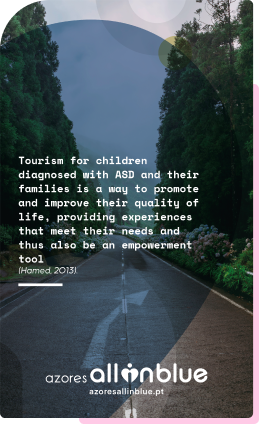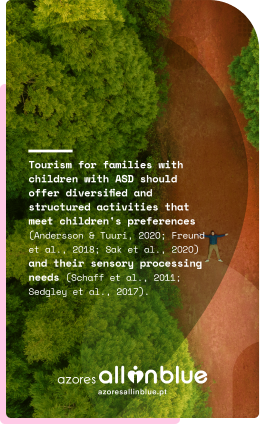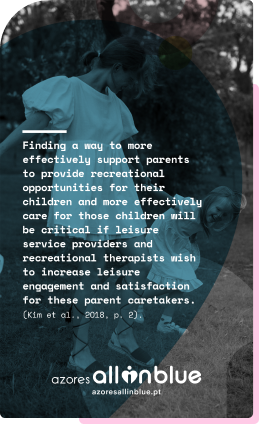What’s our intention with this project?

Identify the touristic and leisure needs of families with children with ASD and, in light of these needs, create products and touristic experiences adapted to the child's specificities while simultaneously promoting the well-being of their caregivers during their leisure and vacation periods.
why this project?
- ASD is a form of diversity, a different way of functioning that society has to contemplate and know how to deal with (Armstrong, 2010; Hamed, 2013; Robertson & Ne’eman, 2008).
- It is not the children with ASD and their families that have to adapt, but society, institutions, services, professionals that must adjust to their specificity and diversity.
- Tourism and leisure are no exception and must be at the forefront.
- It is not the children with ASD and their families that have to adapt, but society, institutions, services, professionals that must adjust to their specificity and diversity.
- Tourism and leisure are no exception and must be at the forefront.

What are the benefits for
the child and for the families?

- Tourism is a central instrument for achieving the essential dimensions for the quality of life of children with ASD:
i. Emotional well-being (feelings of pleasure, happiness, decreased stress levels)
ii. Interpersonal relationships (interaction with others, friendships and social support)
iii. Physical well-being (which implies recreation and leisure)
iv. Social inclusion (involvement in community activities)
- Tourism can be a way to promote and improve the quality of life of children with ASD and act as an empowerment tool.
- The investigation indicates that caregivers of children with ASD are subject to high levels of demand and burden, also needing leisure and recreation experiences – family members should also be the target of attention and need specific responses from tourism.
i. Emotional well-being (feelings of pleasure, happiness, decreased stress levels)
ii. Interpersonal relationships (interaction with others, friendships and social support)
iii. Physical well-being (which implies recreation and leisure)
iv. Social inclusion (involvement in community activities)
- Tourism can be a way to promote and improve the quality of life of children with ASD and act as an empowerment tool.
- The investigation indicates that caregivers of children with ASD are subject to high levels of demand and burden, also needing leisure and recreation experiences – family members should also be the target of attention and need specific responses from tourism.
How important is the collaboration of families?
- Families with children with ASD are the main source of information to be able to develop products aimed attheir needs.
- The collaboration of the families is the basis of the project, giving voice to their needs and the specificities of the children who need to be considered by the tourism sector.
- The vision and experience of the families need to be considered in order to effectively achieve the objective of this project: to develop and implement products and touristic experiences adapted to children with ASD and their families.
- The collaboration of the families is the basis of the project, giving voice to their needs and the specificities of the children who need to be considered by the tourism sector.
- The vision and experience of the families need to be considered in order to effectively achieve the objective of this project: to develop and implement products and touristic experiences adapted to children with ASD and their families.

To participate, sign up using the form below
Survey Now Closed


